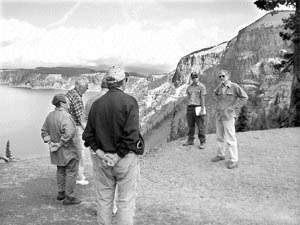Geologist’s talk rebuilds a mountain
Herald and News
Klamath Falls, Oregon
August 25, 2004
By LEE JUILLERAT
CRATER LAKE – A volcano came alive Saturday, at least in the minds of those listening to a volcanologist who has spent more than 20 years studying the geology of Crater Lake.
Mount Mazama, the mountain that rose about 12,000 feet above sea level before a series of climatic eruptions 7,700 years ago created the caldera known as Crater Lake, was resurrected by Charles “Charlie” Bacon, a U.S. Geologic Survey volcanologist.
Bacon, who rewrote the geological textbooks on Crater Lake, guided visitors through the mountain’s and lake’s history during a tour around Crater Lake National Park’s Rim Drive.
|
The tour came as a prelude to ceremonies held by the Crater Lake Institute to honor Bacon with its Centennial Award for Excellence in Scientific Research.
Bacon’s research at Crater Lake began in 1979 when, as a young geologist, he decided it was “pretty obvious to me this was the place you’d learn some stuff … We can learn a lot about what goes on in the earth by seeing what happens here.”
A significant amount of Bacon’s work and research included collecting rock samples from the steep, unstable caldera walls.
“I’ve been everywhere where it isn’t vertical,” he said.
His research hasn’t come without some concerns.
“I was kind of scared. There’s something about having that lake down there that makes it scarier. I’m a coward, and I didn’t want to die,” admitted Bacon, 55.
Bacon’s park studies were especially intense during the 1980s, when he explored, sampled and reinterpreted earlier work by J.S. Diller in 1902 and Howell Williams in the 1930s and ’40s.
Bacon took his tour group around the lake, stopping at Discovery Point, Cleetwood, the Pumice Castle overlook, Kerr Notch and other areas to explain aspects of the region’s volcanic history.
“There’s been a volcanic terrain here going back at least 30 million years,” Bacon said at an overlook above Cleetwood Cove. He described the Cleetwood area as “a clock that shows you what happened – bang, bang, bang.”
He described how the rock provides evidence that reveals the Cleetwood lava flow occurred only “10s of years prior to the climatic explosions” and indicates that the eruptions that drained the mountain of its magma and gas, and led to Mazama’s collapse, happened in only a few days.
Bacon said it’s estimated Mazama erupted 50 cubic kilometers of magma. In comparison, the 1980 eruption of Mount St. Helens discharged 2/10 of a kilometer.
“It devastated everything. Fried it,” Bacon said. “Any forest that was here, any animals, were just vaporized.”
He believes the eruption began at the northeast corner of the caldera, or north of Mazama’s summit.
“Once it started it was like a chain reaction,” explained Bacon, who said the emptied mountain collapsed even as the eruption occurred. “This is such a spectacular example of a big, nasty volcano that exploded.”
In outlining the region’s geologic history, he said the Phantom Ship, a football-field-length rocky island in the southeast corner of the lake, was created about 400,000 years ago – “That’s the guts of the oldest part of the volcano.”
He believes that from 400,000 years ago until about 30,000 years ago, a series of eruptive occurrences and glaciation periods helped shape and reshape the mountain. About 30,000 years that activity “settled down,” allowing the magma to accumulate. Leaks, or lava flows, about 8,000 years ago created Llao Rock, one of the rim’s most dominate features, setting the stage for the massive eruption sequence.
Bacon said the series of eruptive events, which began much smaller than the climatic explosion, teach a lesson about volcanoes.
“The dangerous thing is to assume that what it did before is what it may be doing next,” he said.
Although geologically quiet, the lake shows signs of activity, from occasional earthquakes to some light warming from geothermal activity.
“It’s certain that sometime in the future there will be volcanic activity here,” Bacon said. “Chances are it has not quit.”
Regional Editor Lee Juillerat covers Lake, Siskiyou, Modoc and northern Klamath counties. He can be reached at 885-4421, (800) 275-0982, or by e-mail at lee@heraldandnews.com.
***previous*** — ***next***


